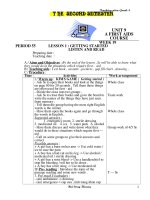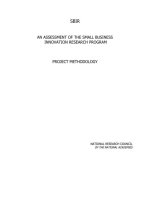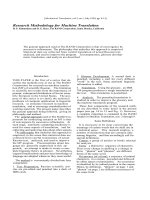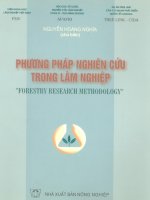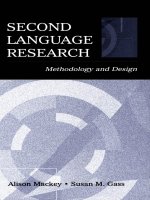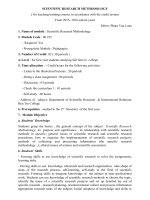Research methodology course
Bạn đang xem bản rút gọn của tài liệu. Xem và tải ngay bản đầy đủ của tài liệu tại đây (5.95 MB, 94 trang )
Research Methodology
RESEARCH
METHODOLOGY
COURSE
HEALTH, SAFETY & ENVIRONMENT
“Hazards At The Workplace”
Azizul Buang
April 2014
© Azizul Buang/UTP 2012
Research Methodology
n
n
n
n
n
n
We are now at Seminar Room/Undercroft Seminar Hall of
Chancellor Complex.
For your safety, please observe the exit signs at the doors
of this room/hall.
Should the alarm be activated, please remain calm. Our
staff will investigate to confirm and give further instructions
through the public address system.
Should there be an emergency, please leave the room/hall
through the nearest door. Proceed to the Assembly Area
which is located in front of this building and wait for further
instructions from our staff.
To prevent any incident during evacuation, please be
careful when using staircase to the Chancellor Complex
Foyer.
Thank you.
Safety
Briefing Undercroft
Research Methodology
~ Hall
© Azizul Buang/UTP 2012
Safety
Briefing Undercroft
Research Methodology
~ Hall
© Azizul Buang/UTP 2012
Research Methodology
Assembly Area
© Azizul Buang/UTP 2012
6
Research Methodology
Defining Health, Safety & Environment
n
Health is defined as both physical and mental
well being.
n
Environment is the surroundings or conditions
in which a person, animal, or plant lives or
operates
7
Research Methodology
Defining Health, Safety & Environment
Safety – freedom from
danger/hazard, risks or
accidents that may
result in injury, death or
property damage
Safety is the control of unplanned events.
8
Research Methodology
What is HSE target?
n
Zero accidents.
n
Zero (physical and mental) illness and
disease.
n
Zero loss of containment / pollution
n
Good general well being.
9
Research Methodology
Definition
Accident - Harm or
loss to an individual
or property
Hazard + Exposure = Accident
Physical exposure = person within arm’s
length with hazard
Environmental exposure = due to noise &
temperature extremes, hazardous atmospheres
10
Research Methodology
Definition
Hazard - Anything
that can cause
damage or harm
Unsafe
condition
Unsafe act
11
Research Methodology
n
Hence, for safety reason, need to be able to
Identify the hazard
Control and minimise hazard and exposure
Prevent any accident
Or Minimise consequences
Research Methodology
Hazards At The Workplace
Overview
n Chemical and Biological hazards
n Mechanical and Ergonomic hazards
n Electrical and Fire hazards
n
Research Methodology
Overview
HAZARD
Generally anything that can hurt you or make you ill causes harm if not controlled
OUTCOME
Harm that results from uncontrolled hazard
RISK
Combination of the probability of harm and the severity of harm
RISK = Probability (of harm) x Consequences (of harm)
Example:
The HAZARD : repetitive manual handling of heavy objects is a hazard.
The OUTCOME : musculoskeletal disorder (MSD) or an acute back/joint injury.
The RISK : expressed numerically (0.5 or 50/50 chance) or relative terms
(high/medium/low)
Research Methodology
Research Methodology
Research Methodology
Overview
Common Hazard Category
Physical hazards
n Chemical and Biological hazards
n Mechanical and Ergonomic hazards
n Electrical and Fire hazards
n
Research Methodology
Physical Hazards
The most common in most workplaces at one time or another.
Include unsafe conditions that can cause injury, illness and death
Typically easiest to spot but, sadly, too often overlooked because
of:
1.
familiarity (there are always cords running across the
aisles),
2.
lack of knowledge (they aren't seen as hazards),
3.
resistance to spending time or money to make
necessary improvements
4.
simply delays in making changes to remove the hazards
18
Research Methodology
INCIDENT REPORT
1)
Falling Ceiling at Block 19 on 4th Jan
2012
n)
C-Channel aluminum suspended ceiling frame together
with MDF board felt.
Glassware and lab apparatus affected and no injury
occurs in this incident.
n)
19
Research Methodology
INCIDENT REPORT
Research Methodology
Chemical Hazards
Characteristics of hazardous chemicals
n
Corrosive
o
o
Chemicals that is able to corrode steel or
harm organisms because of extreme acidic or
basic properties
(dissolves metals, burns the skin or has a pH
≤ 2 or pH ≥ 12.5)
Research Methodology
Chemical Hazards
Characteristics of hazardous chemicals
n
Reactive
o
n
unstable or undergoes rapid or violent chemical
reaction with water, air or other materials
Toxic
o
capable of releasing specified substances that
are poisonous or can cause cancer, mutations or
death
Research Methodology
Minor explosion at Chemical Eng FYP
lab The explosion was due to the chemical mixture
mixed with water in the piping of the sink.
Incompatibility led to the explosion .
Research Methodology
Chemical Hazards
Effects of methyl
mercury poisoning
Mesothelioma
from exposure to
asbestos
Chronic dermatitis due
to prolonged exposure
to chemicals
Research Methodology
Chemical Hazards
Hazard during
•
Transport
•
Delivery
•
Storage
•
Housekeeping
25
Research Methodology
REPORT
FireINCIDENT
in Standalone
Fume Hood Cupboard on
16th Apr 2012
n
n
n
A PhD student was running an experiment to make a
membrane solution using polysulfone, NMP and DEA.
The solution was put into an experiment bottle and
capped before it was heat directly on the hot-plate at
setting temperature of 80o C.
The experiment was conducted in the ductless fume
hood specifically meant for Ionic Liquid vapor acid
experiment.
